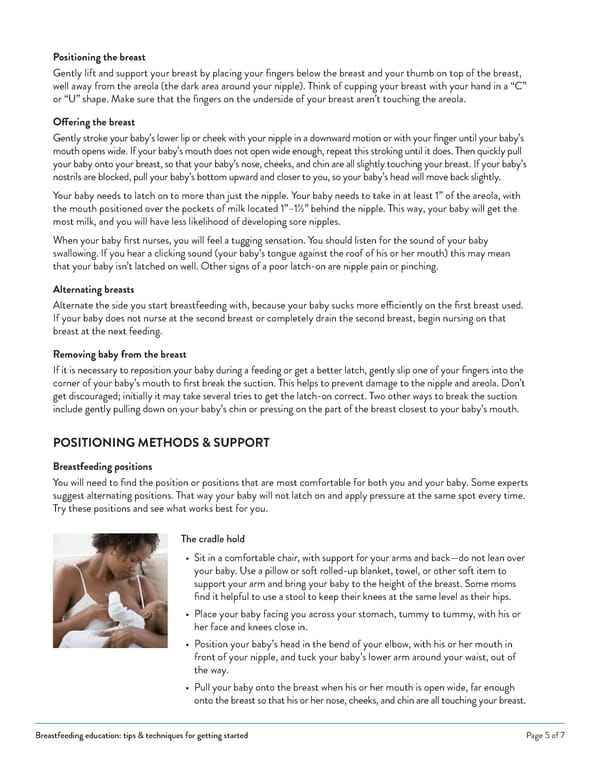Positioning the breast Gently lift and support your breast by placing your fingers below the breast and your thumb on top of the breast, well away from the areola (the dark area around your nipple). Think of cupping your breast with your hand in a “C” or “U” shape. Make sure that the fingers on the underside of your breast aren’t touching the areola. Offering the breast Gently stroke your baby’s lower lip or cheek with your nipple in a downward motion or with your finger until your baby’s mouth opens wide. If your baby’s mouth does not open wide enough, repeat this stroking until it does. Then quickly pull your baby onto your breast, so that your baby’s nose, cheeks, and chin are all slightly touching your breast. If your baby’s nostrils are blocked, pull your baby’s bottom upward and closer to you, so your baby’s head will move back slightly. Your baby needs to latch on to more than just the nipple. Your baby needs to take in at least 1” of the areola, with the mouth positioned over the pockets of milk located 1”–1½” behind the nipple. This way, your baby will get the most milk, and you will have less likelihood of developing sore nipples. When your baby first nurses, you will feel a tugging sensation. You should listen for the sound of your baby swallowing. If you hear a clicking sound (your baby’s tongue against the roof of his or her mouth) this may mean that your baby isn’t latched on well. Other signs of a poor latch-on are nipple pain or pinching. Alternating breasts Alternate the side you start breastfeeding with, because your baby sucks more efÏciently on the first breast used. If your baby does not nurse at the second breast or completely drain the second breast, begin nursing on that breast at the next feeding. Removing baby from the breast If it is necessary to reposition your baby during a feeding or get a better latch, gently slip one of your fingers into the corner of your baby’s mouth to first break the suction. This helps to prevent damage to the nipple and areola. Don’t get discouraged; initially it may take several tries to get the latch-on correct. Two other ways to break the suction include gently pulling down on your baby’s chin or pressing on the part of the breast closest to your baby’s mouth. POSITIONING METHODS & SUPPORT Breastfeeding positions You will need to find the position or positions that are most comfortable for both you and your baby. Some experts suggest alternating positions. That way your baby will not latch on and apply pressure at the same spot every time. Try these positions and see what works best for you. The cradle hold • Sit in a comfortable chair, with support for your arms and back—do not lean over your baby. Use a pillow or soft rolled-up blanket, towel, or other soft item to support your arm and bring your baby to the height of the breast. Some moms find it helpful to use a stool to keep their knees at the same level as their hips. • Place your baby facing you across your stomach, tummy to tummy, with his or her face and knees close in. • Position your baby’s head in the bend of your elbow, with his or her mouth in front of your nipple, and tuck your baby’s lower arm around your waist, out of the way. • Pull your baby onto the breast when his or her mouth is open wide, far enough onto the breast so that his or her nose, cheeks, and chin are all touching your breast. Breastfeeding education: tips & techniques for getting started Page 5 of 7
 Breastfeeding education: tips & techniques for getting started Page 4 Page 6
Breastfeeding education: tips & techniques for getting started Page 4 Page 6